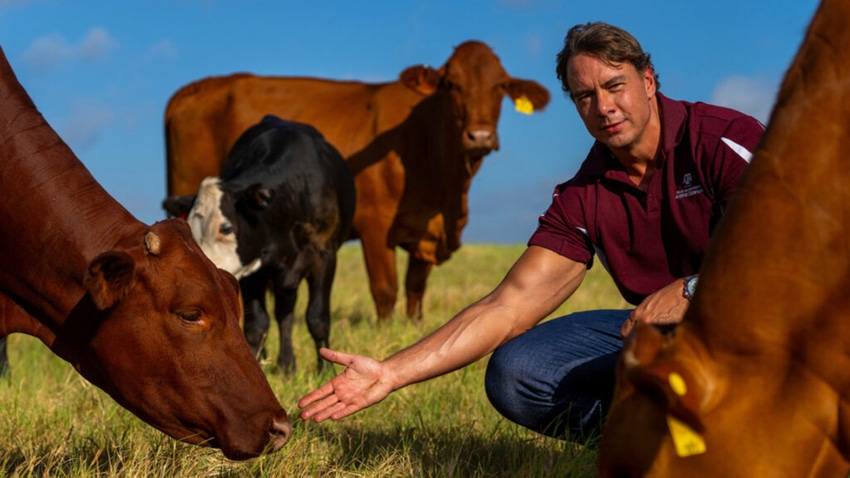
Utilizing omega-6 fatty acids as a management strategy to mitigate early embryonic loss, a major cause of reproductive and economic losses to the U.S. beef industry, is the focus of a new Texas A&M AgriLife Research-led project.
Omega-6 fatty acids have long been touted as essential fatty acids in human health and are typically derived from vegetable oils, seeds and nuts.
A team of researchers in the Texas A&M College of Agriculture and Life Sciences Department of Animal Science has determined these same fatty acids could be a management tool in cattle pregnancies, particularly the first 28 days of gestation.
Advancing cow-calf productivity
Reinaldo Cooke, the Burkhart Endowed Professor for Beef Cattle Research in the Department of Animal Science, said cow-calf systems represent 86% of beef operations and 84% of the beef cattle population in the country. However, reproductive failure is a key factor limiting cow-calf productivity, and pregnancy loss has been recognized as one of the main reproductive challenges in cattle.
Most pregnancy losses occur during the first 28 days of gestation, he said, and these losses are classified as early embryonic loss.
“Our group provided evidence that supplementing beef cows with a lipid source rich in omega-6 fatty acids during the early embryonic period increased pregnancy success by promoting conceptus development, establishment and maintenance of the pregnancy,” Cooke said.
These results diverged from the traditional concept developed in the dairy industry that omega-6 fatty acids are detrimental to early pregnancy, so Cooke said the mechanisms by which omega-6 fatty acids improved pregnancy success warrant full clarification.
“We need to provide biological support to nutritional interventions that minimize early embryonic loss,” he said.
The research project
Cooke said they are searching for the optimal nutritional additives to provide beef cattle during the breeding season.
Omega-6 fatty acids act as an inflammatory and have been fed in beef cattle diets, but they need answers on how much is too much. And omega-3 fatty acids, which have the opposite effect as an anti-inflammatory, are not commonly fed to beef cattle, so there is no data.
“We want to answer questions of how much omega-6 is too much; that’s the first project,” he said. “The second project is comparing the two, using the dose of omega-6 that we know works and then see if omega-3 has complementary effects.”
He explained that the healing process in a body is mediated by inflammation – inflammation stimulates the growth of certain cells and body reactions. So, in their research, they are looking to determine how much is just enough to add fuel for embryo growth and positive pregnancy development.
Dairy cows inherently eat a lot of fat, so when fed high amounts of omega-6 there were negative effects on reproduction. But in beef cattle, it’s unknown how much is too much.
“The omega-6 fuels the embryo to develop,” he said. “But if we increase the omega-6 to a higher level, will the reproductive effects be negative as in the dairy industry? It may cause too much inflammation. And then, if we know how much omega-6 is good, how does that compare to omega-3 at different rates.”
The idea is to determine if there are complementary effects between the two, as omega-3 would be good in terms of preventing too much inflammation, but omega-6 fatty acids would provide fuel for embryo development.
“It’s fine-tuning what is too much or too little,” he said. “We want to find the balance between the two to find good nutritional strategies for beef cattle reproductive management.”
Research team
Cooke will lead the U.S. Department of AgricultureNational Institute of Food and Agriculture-funded project, Unraveling the Benefits of Feeding a Lipid Source Rich in Omega-6 Fatty Acids to Pregnancy Establishment and Maintenance in Beef Females.
Joining Cooke from the Department of Animal Science will be Rodolfo Cardoso, DVM, associate professor and reproductive physiologist, and Ky Pohler, associate professor and chair of the Pregnancy and Developmental Programming Area of Excellence.
Others on the grant project are Vitor Mercadante, DVM, professor, Department of Large Animal Clinical Sciences, College of Veterinary Medicine, Virginia Tech University, Blacksburg; Pedro Fontes, assistant professor, beef cattle reproductive physiology, Department of Animal and Dairy Science, University of Georgia, Athens; Martha Ortega Obando, assistant professor of reproductive physiology, University of Wisconsin-Madison.
About the Author(s)
You May Also Like




